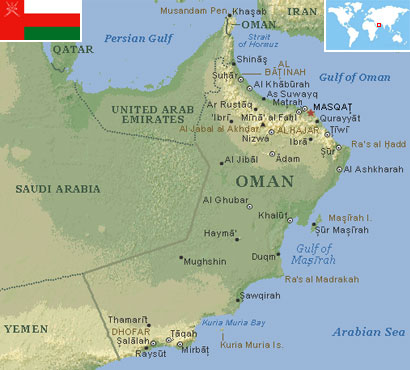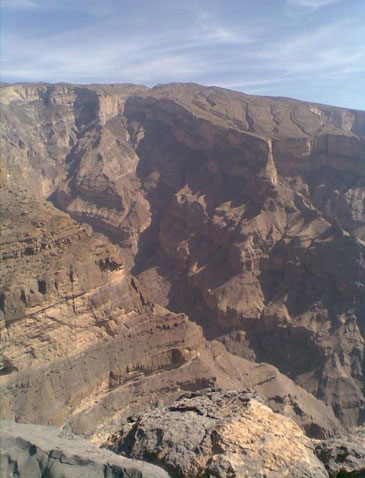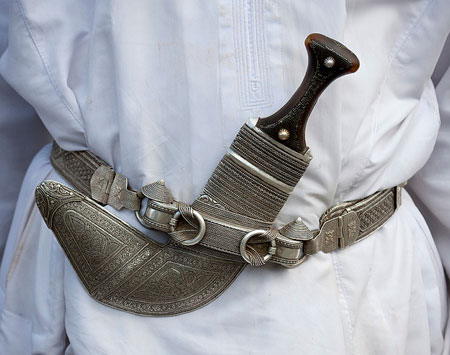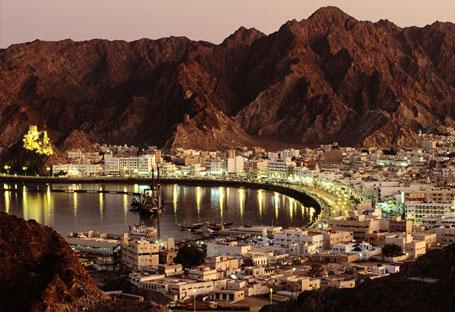Oman
Country statistics

Total area: 82,031 sq miles (212,460 sq km)
Population (2010 est.): 2,967,717 (growth rate: 1.9%); birth rate: 23.9/1000; infant mortality rate: 16.8/1000; life expectancy: 74.1; density per sq miles: 15
Capital City: Muscat
Monetary unit: Omani rial
Languages: Arabic (official), English, Baluchi, Urdu, Indian dialects
Ethnicity/race: Arab, Baluchi, South Asian (Indian, Pakistani, Sri Lankan, Bangladeshi), African
Religions: Islam: Ibadhi 75%, Sunni, Shi'a; Hindu
Country introduction

Oman is a Middle East country situated in South-west Asia, bordering Saudi Arabia and the United Arab Emirates to the west, Yemen to the south, the Strait of Hormuz in the north and the Arabian Sea to the east.
With an area of over 300,000 sq km (186,411 sq miles), Oman is one of the most geographically diverse countries of the Peninsula. Arid deserts meet fertile plains and mountains in the north, while a seasonal monsoon yields green plains and mountains in Dhofar of southern Oman.
Around 82% of the land is made up of sand and gravel desert, 15% is mountainous and the remaining 3% comprises coastal plains. The inhospitable but famous Rub Al Khali (Empty Quarter) lies to the west of the country, but elsewhere there are many lush wadis and oases.
The interior region of Oman is separated from the coast by the Al Hajar Mountain range, which stretches along the centre of the northern part of the country for 600 km (372 miles). Jebel Shams, at an altitude of 3,075 m (10,089 ft), is Oman's highest mountain. In Musandam, where the Strait of Hormuz lies between the Omani and Iranian coasts, the mountains soar to a height of 1,800 m (5,905 ft) above sea level. Although the mountains only cover about one-sixth of the country, they have always dominated and determined the pattern of settlement there.
Oman's coastline stretches for over 1,700 km (1,056 miles) and borders the Sea of Oman and the Arabian Sea. The strategically important Strait of Hormuz is the only stretch of water between the Gulf and the Indian Ocean and is, therefore, a vital route for the transportation of crude oil, gas and cargo.
The culture

The Omani culture has its roots firmly in the Islamic religion. Oman developed its own particular form of Islam, called Ibadhism, after its founder, Abdullah ibn Ibadh who lived during the 7th century AD. Not all Omanis are Ibadhis, however, there are also Sunni Muslims and Shia Muslims. Omanis are not only tolerant of the beliefs of different Muslim divisions, they are also tolerant towards believers of other faiths, who are allowed to practise their religion in churches and temples. Islam is based on the fulfillment of the 'Five Pillars of Islam' or the hadiths. By fulfilling these duties one is assured of a place in heaven.
Islamic festivities are very important events in Omani culture. All Muslims are obliged to fast during Ramadhan, one of the Pillars of Islam. For around 29 to 30 days, each Islamic year, Muslims refrain from smoking, eating and drinking during the hours of fasting (from sunrise to sunset). Ramadhan advances 10 to 11 days each year as it is governed by the lunar calendar. The Haj or pilgrimage is another Pillar of Islam. The pilgrims travel to al-Medina in Saudi Arabia to visit the Prophet's tomb before travelling to the holy sites in Mecca. In 1999, there were approximately 19,000 Muslims travelling from Oman to Saudi Arabia. The pilgrimage is organised and coordinated by the Ministry, which ensures the pilgrims' health and safety during the course of their stay.
Oman is famous for its khanjar knives, which are curved daggers worn during holidays as part of ceremonial dress. Traditional clothing worn by most Omani men include an ankle-length, collarless robe called a dishdasha that buttons at the neck with a tassel hanging down. Traditionally this tassel would be dipped in perfume. Today the tassel is merely a traditional part of the dishdasha. Women wear hijab and abaya. Some women cover their faces and hands, but most do not. The abaya is a traditional dress and it is current having different styles. The Sultan has forbidden the covering of faces in public office. On holidays, such as Eid, the women wear traditional dress, which is often very brightly colored and consists of a mid-calf length tunic over pants.
Being a seafaring nation, an important symbol in Oman is the dhow. These sailing ships have been used for centuries along the Arabian Peninsula, India and East Africa for the purpose of trade. In fact, the earliest reported use of an Omani dhow was in the 8th century, arriving in China. In modern day use, the dhow operate for the purpose of trade, tourism and fishing, and they can be seen all along Oman's coastline. The main ports of Sohar, Sur, Salalah and Muscat all maintain a large fleet, while Sur maintains an extensive dhow building industry.
Cuisines of Oman represent a great variety. They are highly delicious and unique from other Arab countries. Kahwa is a bitter drink like coffee flavored with cardamom. This is often served with Lokhemat, a deep-fried ball of flour and yeast spiced with dry fruits and nuts. Cooked rice, meat, fish and bread are the main ingredients of most Omani dishes like maqbous and aursia. Other Omani specials are buttermilk drinks, salads and soups. Shuva is a popular festive meal requiring an elaborate preparation, often by the whole village community. To make this, a whole cow is roasted up for two days in a special oven placed in a pit dug in the ground. The meat becomes extremely tender and is then spiced elaborately.
Attractions & landmarks

Oman is a country of enormous diversity and natural beauty, which attracts many international tourists every year.
The capital and commercial centre of Oman, Muscat, retains its heritage more than any of the new-look cities of the Middle East. Muscat comprises of a long string of suburbs, and despite its length feels more like a collection of small towns than a busy metropolis. Muscat is sometimes referred to as three cities: Muscat, Muttrah and Ruwi. The harbour is nestled between the azure waters of the Gulf of Oman and the seemingly impenetrable mountains. Most of the cities sights are in and around Muttrah and the neighbouring Walled City of Muscat. Famous landmarks include Sultan Qaboos Grand Mosque, Muttrah Souq, the forts of Al-Jalali and Al-Mirani which flank his Majesty's colourful and elegant Al-Alam Palace, Burj As-Sahwa, Clock Tower Square, and Al-Bustan Palace Hotel. Muttrah Souq in particular is the oldest market place, which is located behind the Corniche of Muttrah. The Souq is a maze of pathways leading through narrow, winding alleys and by-lanes, and tucked away in a corner is the Gold Souq. Flanking His Majesty the Sultan's Al-Alam Palace, are the so-called Twin Forts: Al-Jalali and Al-Mirani, in conjunction with the veritable defences of the Fort of Muttrah and a host of fortified structures and watchtowers along the rocky ridges of the bay, made Muscat virtually impregnable. Muscat has a number of beautiful beaches such as Qurum Beach, Bandar Al-Jissah and Yeti.
At the far northern tip of Oman, and cut off from the rest, is the Musandam Peninsula, a beak of land pushing out into the Strait of Hormuz and occupying a strategic position overlooking the entry to the Arabian Gulf. The coastline is at its most inviting around Salalah on the Arabian Sea, between Shinas and Mtrah and between Muscat and Sur. The Peninsula is a land of beautiful khors, small villages and dramatic, mountain-hugging roads. It is separated from the rest of Oman by the east coast of the UAE and guards the southern side of the Strait of Hormuz. The best way to see the Peninsula is on an organised tour. Long, lovely beaches, date palms, groves of citrus and lush fields of alfalfa, are backed by the towering Hajar Mountains, whose peaks climb to more than 3,000 m (9,842 ft). The west and centre of the country is a sun-beaten land of shifting sand dunes and thorn bushes, habitable only by a few Bedouin, their camels and goats.
The road from Muscat to Sur is a very scenic 5 hour journey that follows the base of the Eastern Hajar Mountains, and is known for some amazing sights. Some of these sights include the Bimmah Sinkhole, a blue-green water at the bottom of a 40 m x 20 m limestone hole where swimming and snorkeling can be enjoyed. There is also the Wadi Shab, one of the country's most popular walking destinations, known for its aquamarine pools, waterfalls, terraced plantations and kingfishers. Other sights include the Wadi Tiwi, which is home to a string of emerald pools and plantations, with excellent opportunities for walking. It is also worth visiting Qalhat, a 2nd Century AD settlement, and one of Oman's most ancient sites. It is here that the Tomb of Bibi Miriam can be found where Marco Polo stopped in the 13th Century.

Sur is an ancient port and seafaring town that lies on the east coast 310 km (192 miles) from Muscat and played a major part in the trade between Oman, East Africa and India. Sur was one of the renowned centres for shipbuilding in the country, until the arrival of the British India Steam Navigation Company which operated between India and the Gulf. The Sur Maritime Museum charts the history of shipbuilding in the town. With its strong seafaring connections, it is hardly surprising that the legendary sailor, Sinbad, is thought to have originated there.
The Western Hajar Mountains is a dramatic, mountainous region and is Oman's biggest tourist attraction. Here visitors will find: Jebel Shams (Oman's highest mountain); Wadi Ghul (the Grand Canyon of Arabia); and Jebel Akhdar (the fruit bowl of Oman - famous for its fragrant, pink roses from which rosewater is made); and some of the country's best forts, can be seen in Nizwa, Bahla and Jabrin.